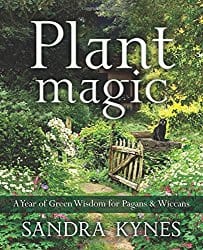


A comparative review between:
Herbs Plain and Simple, by Marlene Houghton
Hampton Roads Publishing, 9781571747662, 176 pp., 2017
Plant Magic: A Year of Green Wisdom for Pagans & Wiccans, by Sandra Kynes
Llewellyn Worldwide, 9780738750170, 264 pp., 2017
The image of the witch mixing potions and throwing in strange plants to make magical things happen is ubiquitous in our culture. There is some truth to it, however. Some plants are stuffed full of magical and healing properties. I looked at two books, Herbs Plain and Simple by Marlene Houghton and Plant Magic: A Year of Green Wisdom for Pagans & Wiccans by Sandra Kynes, in order to identify what would be best for a witch looking for a bit of green magick.
First impressions
Plant Magic is much larger than Herbs Plain and Simple. From an aesthetic standpoint, based on the cover, Plant Magic is far more striking with its pleasant cover photo. Herbs is far more utilitarian as it’s part of the Plain and Simple series from Hampton Roads.
I’m familiar with the series that Herbs is published under, so I knew going in that it would be a book with a lot of information in a small package. True to form, a quick flip through showed me it was full of information on a variety herbs and plants.
Plant Magic covers a good deal of plants, but they were different types of plants (it appeared to have more information on flowers and such), while Herbs has more about roots and, well, herbs.
Both books lack a great deal of illustration. Herbs has a few black and white illustrations of random plants, throughout the text as well as some diagrams of bodies featuring what part the herb in question would help. Aside from some very pretty chapter plates and the simple rune illustrations, Plant Magic lacks any illustrations of actual plants.

The text
I started with Herbs first as it was the smaller book. After a short introduction on herbalism, the book gives an overview of different vocabulary which is used to discuss the herbs’ properties, such as astringent or sedative. It then outlines different ways to prepare the herb, such as teas or tinctures. Both of these sections are quick overviews.
Part two of the book focuses on the different human anatomical body systems (such as the digestive system, the respiratory system, and so on), and how certain herbs will help those systems. Each herb in the section is given a brief description of its qualities from appearance, to smell, and taste. For some herbs, there is also a history attached. After this, information is given on how they are commonly taken.
Despite its claim, this text actually lacks any recipes for the use of these herbs. Instead it tells you how they are commonly purchased, so you can buy them already prepared in a health store. There is a small section at the end on different teas you can prepare, but that’s as far as it goes.
There was some use of yin and yang in the description of the plants in this book as well as some very basic mention of ayurveda; however, this text spends no time explaining any of that. Herbs Plain and Simple has very little, if any, attachment to spirituality. Simply, it is a book on herbology.

Plant Magic is different. It is organized around the calendar year, which is an extremely natural way to view plant life. The book is broken up into months, with every month beginning with a brief overview of the important feast days as well as other notable days for it, and then it dives into the plants themselves.
The entire book is written with the use of magick in mind. To that end, the plants which are included are not, for the most part, edible and the book does not greatly discuss how to prepare the plants that are. For example, burdock is a common plant which has an edible root. Although this is a well-known edible plant (you can make root beer from it), Kynes spends no time discussing this aspect of it. Some chapters do include a small recipe at the end, but this is not for every plant that can be ingested.
The book covers the appearance and life cycle of plants. The bulk of the descriptions are spent in the ritual aspect of the plant — how it is used in magick, specifically, Wiccan-based practices. Although the information it gives about the ritual aspect of plant use is thorough and interesting, I would have liked to see more information here on how to prepare the plants you could eat for magickal uses.
This book includes a detailed section on the parts of plants, which Herbs lacks. It also has a good deal of information on astrology, a practice many people use in conjunction to their work with plants, which helps to place plant work into the broader landscape of magick.

So which one to get?
Each of these books is very different. Herbs is a non-magical text, and offers a great deal of information about plants that will help the body, while Plant Magic is written more for the Pagan or witch in mind, and therefore offers more information on how to help the spirit. However, I think both of these books missed the mark in many ways.
Both Plant Magic and Herbs lack any information on how to acquire these plants, whether they are rare and must be purchased in specialty stores, or if they can be purchased from the grocery story, or can even be grown yourself. This is the sort of information I think would be important for anyone who wants to cultivate a practice around the usage of these and other plants, roots, and herbs. Both of these texts offer a great deal of information which is well-written and accessible, but they both leave the reader with a feeling of “Now what?”
These books are good for what they are. If you are only interested in plants for ritual use and have no intention of learning about things you can eat, then Plant Magic would be the better choice. If you plan to learn more about natural healing, Herbs Plain and Simple is a good place to start, but you’ll have to purchase further books to learn about how to use the different plants for healing, or to incorporate them into your kitchen-based spell work.
Image credit: PerennialsPhotos, *6*








